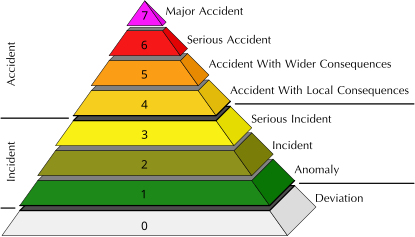The International Nuclear and Radiological Event Scale (INES) was introduced in 1990 by the International Atomic Energy Agency (IAEA) in order to enable prompt communication of safety significance information in case of nuclear accidents.
The scale is intended to be logarithmic, similar to the moment magnitude scale that is used to describe the comparative magnitude of earthquakes. Each increasing level represents an accident approximately ten times more severe than the previous level. Compared to earthquakes, where the event intensity can be quantitatively evaluated, the level of severity of a man-made disaster, such as a nuclear accident, is more subject to interpretation. Because of the difficulty of interpreting, the INES level of an incident is assigned well after the incident occurs. Therefore, the scale has a very limited ability to assist in disaster-aid deployment.
As INES ratings are not assigned by a central body, high-profile nuclear incidents are sometimes assigned INES ratings by the operator, by the formal body of the country, but also by scientific institutes, international authorities or other experts which may lead to confusion as to the actual severity.
A number of criteria and indicators are defined to assure coherent reporting of nuclear events by different official authorities. There are seven nonzero levels on the INES scale: three incident-levels and four accident-levels. There is also a level 0.
The level on the scale is determined by the highest of three scores: off-site effects, on-site effects, and defence in depth degradation.

No comments:
Post a Comment